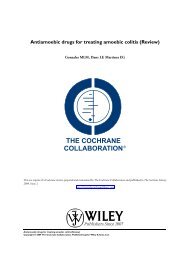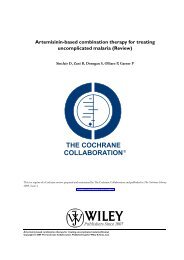Legislative smoking bans for reducing secondhand smoke exposure ...
Legislative smoking bans for reducing secondhand smoke exposure ...
Legislative smoking bans for reducing secondhand smoke exposure ...
You also want an ePaper? Increase the reach of your titles
YUMPU automatically turns print PDFs into web optimized ePapers that Google loves.
acted in many jurisdictions, there is also a need <strong>for</strong> research into the<br />
extent to which <strong>exposure</strong> to SHS in non-<strong>smoking</strong> areas is a result<br />
of <strong>smoke</strong> coming from the outdoor <strong>smoking</strong> areas. Further studies<br />
should utilise larger sample sizes with common agreed measures<br />
<strong>for</strong> <strong>smoking</strong> behaviour and <strong>exposure</strong> to SHS of the study population.<br />
The lack of a reference group in many studies means that it is<br />
difficult to differentiate between secular trends and impact of the<br />
intervention, particularly on secondary outcomes such as active<br />
<strong>smoking</strong> rates. The use of factorial design in research, that is a two<br />
way comparison of interventions, utilizing randomized or quasiexperimental<br />
allocation, would enable differentiation between the<br />
effectiveness of a) <strong>smoking</strong> ban in comparison to a control or reference<br />
region with no ban and b) population subjected to a <strong>smoking</strong><br />
ban with or without other <strong>smoking</strong> cessation intervention(s).<br />
References to studies included in this review<br />
Abrams 2006 {published data only}<br />
Abrams SM, Mahoney MC, Hyland A, Cummings KM, Davis W,<br />
Song L. Early evidence on the effectiveness of clean indoor air<br />
legislation in New York State. American Journal of Public Health<br />
2006;96:296–8.<br />
Akhtar 2007 {published data only}<br />
Akhtar PC, Currie DB, Currie CE, Haw SJ. Changes in child<br />
<strong>exposure</strong> to environmental tobacco <strong>smoke</strong> (CHETS) study after<br />
implementation of <strong>smoke</strong>-free legislation in Scotland:national<br />
cross-sectional survey. BMJ 2007;335(7619):546–9.<br />
Alcouffe 1997 {published data only}<br />
Alcouffe J, Fabin C, Brehier M, Fleuret C, Botran-Aly C, Simonnet<br />
M, et al. Smoking prohibition effect on tobacco habits in Paris area<br />
small firms. Archives des Maladies Professionnelles et de Medecine du<br />
Travail 1997;58(5):455.<br />
Allwright 2005 {published data only}<br />
Allwright S, Paul G, Greiner B, Mullally BJ, Pursell L, Kelly A, et<br />
al. Legislation <strong>for</strong> <strong>smoke</strong>-free workplaces and health of bar workers<br />
in Ireland: be<strong>for</strong>e and after study. BMJ 2005;331:1117–20.<br />
Barone-Aldesi 2006 {published data only}<br />
Barone-Aldesi F, Vizzini L, Merletti F, Richiardi L. Short-term<br />
effects of Italian <strong>smoking</strong> regulation on rates of hospital admission<br />
<strong>for</strong> acute myocardial infarction. European Heart Journal 2006;27:<br />
2468–72.<br />
Bartecchi 2006 {published data only}<br />
Bartecchi C, Alsever RN, Nevin-Woods C, Thomas WM, Estacio<br />
RO, Bucher Bartelson B. Reduction in the incidence of acute<br />
myocardial infarction associated with a citywide <strong>smoking</strong><br />
ordinance. Circulation 2006;114:1490–96.<br />
Biener 2007 {published data only}<br />
Biener L, Garrett CA, Skeer M, Siegel M, Connolly G. The effects<br />
on <strong>smoke</strong>rs of Boston’s <strong>smoke</strong>-free bar ordinance: a longitudinal<br />
analysis of changes in compliance, patronage, policy support, and<br />
<strong>smoking</strong> at home. Journal of Public Health Management and<br />
Practice 2007;13:630–6.<br />
R E F E R E N C E S<br />
Such designs are feasible in large countries with federal, regional<br />
and state level structures and preliminary evidence to date suggests<br />
that public <strong>bans</strong> are effective but need to be contextualized<br />
as part of wider anti-<strong>smoking</strong> policy. More research is required on<br />
the long term impact of <strong>smoking</strong> <strong>bans</strong> on the health outcomes of<br />
specific subgroups of the population such as the young children,<br />
disadvantaged and minority groups.<br />
A C K N O W L E D G E M E N T S<br />
We wish to acknowledge support and advice from the Cochrane<br />
Tobacco Addiction Review Group.<br />
Bondy 2009 {published data only}<br />
Bondy SJ, Zhang B, Kreiger N, Selby P, Benowitz N, et al. Impact<br />
of an indoor <strong>smoking</strong> ban on bar workers’ <strong>exposure</strong> to <strong>secondhand</strong><br />
<strong>smoke</strong>. Journal of Occupational and Environmental Medicine 2009;<br />
51:612–9.<br />
Braverman 2008 {published data only}<br />
Braverman MT, Aarø LE, Hetland J. Changes in <strong>smoking</strong> among<br />
restaurant and bar employees following Norway’s comprehensive<br />
<strong>smoking</strong> ban. Health Promotion International 2008;23:5–15.<br />
Brownson 1995 {published data only}<br />
Brownson RC, Davis JR, Jackson-Thompson J, Wilkerson JC.<br />
Environmental tobacco <strong>smoke</strong> awareness and <strong>exposure</strong>: impact of a<br />
statewide clean indoor air law and the report of the US<br />
Environmental Protection Agency. Tobacco Control 1995;4:132–8.<br />
CDC 2007 {published data only}<br />
Pechacek T, Kaufmann R, Trosclair A, Caraballo R, Caudill S.<br />
Reduced <strong>secondhand</strong> <strong>smoke</strong> <strong>exposure</strong> after implementation of a<br />
comprehensive statewide <strong>smoking</strong> ban-New York, June 26, 2003-<br />
June 30 2004. Morbidity & Mortality Weekly Report 2007;56(28):<br />
705–8.<br />
Cesaroni 2008 {published data only}<br />
Cesaroni G, Forastiere F, Agabiti N, Valente P, Zuccaro P, Perucci<br />
CA. Effect of the Italian <strong>smoking</strong> ban on population rates of acute<br />
coronary events. Circulation 2008;117:1183–8.<br />
Eagan 2006 {published data only}<br />
Eagan T. Decline in respiratory symptoms in service workers five<br />
months after a public <strong>smoking</strong> ban. Tobacco Control 2006;15:<br />
242–6.<br />
Eisner 1998 {published data only}<br />
Eisner MD, Smith AK, Blanc PD. Bartenders’ respiratory health<br />
after establishment of <strong>smoke</strong>-free bars and taverns. JAMA 1998;<br />
280:1909–14.<br />
Ellingsen 2006 {published data only}<br />
Ellingsen DG, Fladseth G, Daae HL, Gjolstad M, Kjaerheim K,<br />
Skogstad M, et al. Airborne <strong>exposure</strong> and biological monitoring of<br />
<strong>Legislative</strong> <strong>smoking</strong> <strong>bans</strong> <strong>for</strong> <strong>reducing</strong> <strong>secondhand</strong> <strong>smoke</strong> <strong>exposure</strong>, <strong>smoking</strong> prevalence and tobacco consumption (Review)<br />
Copyright © 2010 The Cochrane Collaboration. Published by John Wiley & Sons, Ltd.<br />
12








